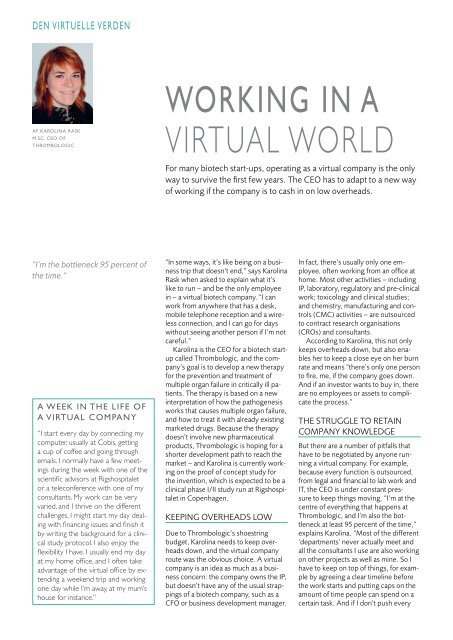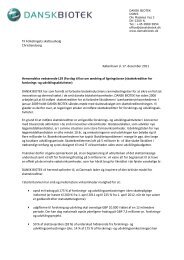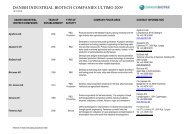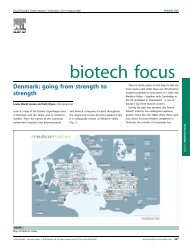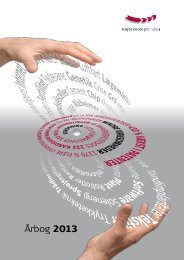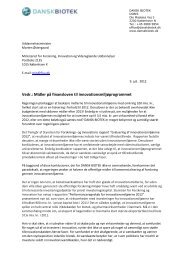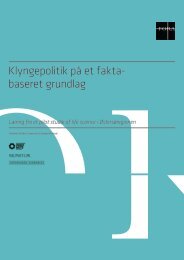Dansk Biotek Magasinet nr. 1 2010
Dansk Biotek Magasinet nr. 1 2010
Dansk Biotek Magasinet nr. 1 2010
You also want an ePaper? Increase the reach of your titles
YUMPU automatically turns print PDFs into web optimized ePapers that Google loves.
d e n V i rt u e L L e V e r d e n<br />
Af kAroLinA rAsk<br />
m.sC. Ceo of<br />
thromBoLogiC<br />
“I’m the bottleneck 95 percent of<br />
the time.”<br />
A Week in the Life of<br />
A VirtuAL CompAny<br />
“I start every day by connecting my<br />
computer, usually at Cobis, getting<br />
a cup of coffee and going through<br />
emails. I normally have a few meetings<br />
during the week with one of the<br />
scientific advisors at Rigshospitalet<br />
or a teleconference with one of my<br />
consultants. My work can be very<br />
varied, and I thrive on the different<br />
challenges. I might start my day dealing<br />
with financing issues and finish it<br />
by writing the background for a clinical<br />
study protocol. I also enjoy the<br />
flexibility I have. I usually end my day<br />
at my home office, and I often take<br />
advantage of the virtual office by extending<br />
a weekend trip and working<br />
one day while I’m away, at my mum’s<br />
house for instance.”<br />
Working in A<br />
VIRTUAL WORLD<br />
For many biotech start-ups, operating as a virtual company is the only<br />
way to survive the first few years. The CEO has to adapt to a new way<br />
of working if the company is to cash in on low overheads.<br />
“In some ways, it’s like being on a business<br />
trip that doesn’t end,” says Karolina<br />
Rask when asked to explain what it’s<br />
like to run – and be the only employee<br />
in – a virtual biotech company. “I can<br />
work from anywhere that has a desk,<br />
mobile telephone reception and a wireless<br />
connection, and I can go for days<br />
without seeing another person if I’m not<br />
careful.”<br />
Karolina is the CEO for a biotech startup<br />
called Thrombologic, and the company’s<br />
goal is to develop a new therapy<br />
for the prevention and treatment of<br />
multiple organ failure in critically ill patients.<br />
The therapy is based on a new<br />
interpretation of how the pathogenesis<br />
works that causes multiple organ failure,<br />
and how to treat it with already existing<br />
marketed drugs. Because the therapy<br />
doesn’t involve new pharmaceutical<br />
products, Thrombologic is hoping for a<br />
shorter development path to reach the<br />
market – and Karolina is currently working<br />
on the proof of concept study for<br />
the invention, which is expected to be a<br />
clinical phase I/II study run at Rigshospitalet<br />
in Copenhagen.<br />
KEEPING OVERHEADS LOW<br />
Due to Thrombologic’s shoestring<br />
budget, Karolina needs to keep overheads<br />
down, and the virtual company<br />
route was the obvious choice. A virtual<br />
company is an idea as much as a business<br />
concern: the company owns the IP,<br />
but doesn’t have any of the usual strappings<br />
of a biotech company, such as a<br />
CFO or business development manager.<br />
In fact, there’s usually only one employee,<br />
often working from an office at<br />
home. Most other activities – including<br />
IP, laboratory, regulatory and pre-clinical<br />
work; toxicology and clinical studies;<br />
and chemistry, manufacturing and controls<br />
(CMC) activities – are outsourced<br />
to contract research organisations<br />
(CROs) and consultants.<br />
According to Karolina, this not only<br />
keeps overheads down, but also enables<br />
her to keep a close eye on her burn<br />
rate and means “there’s only one person<br />
to fire, me, if the company goes down.<br />
And if an investor wants to buy in, there<br />
are no employees or assets to complicate<br />
the process.”<br />
THE STRUGGLE TO RETAIN<br />
COMPANY KNOWLEDGE<br />
But there are a number of pitfalls that<br />
have to be negotiated by anyone running<br />
a virtual company. For example,<br />
because every function is outsourced,<br />
from legal and financial to lab work and<br />
IT, the CEO is under constant pressure<br />
to keep things moving. “I’m at the<br />
centre of everything that happens at<br />
Thrombologic, and I’m also the bottleneck<br />
at least 95 percent of the time,”<br />
explains Karolina. “Most of the different<br />
‘departments’ never actually meet and<br />
all the consultants I use are also working<br />
on other projects as well as mine. So I<br />
have to keep on top of things, for example<br />
by agreeing a clear timeline before<br />
the work starts and putting caps on the<br />
amount of time people can spend on a<br />
certain task. And if I don’t push every


